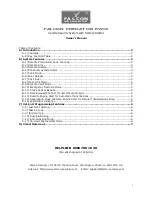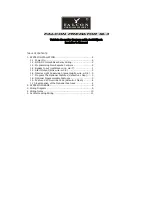
User Manual - PolyGard
®
CO SPC-1110
Page
3
PolyGard
is a registered trademark of MSR
SPC1110I01
Phone (858) 578-7887 & (888) GO IN
TEC
Fax (858) 578-4633 & (888) FX IN
TEC
Specification subject to change without notice.
IN
TEC
Controls, Inc., P.O. Box 12506, La Jolla, CA 92039
www.inteccontrols.com
Printed in USA 040401
Carbon monoxide (CO) gas detection and control system
1 General Overview
The PolyGard
CO analog single point controller is used for detection of carbon monoxide in the ambient air to
warn of the presence of carbon monoxide gas and to control ventilation systems.
2 Description
Gas sensing
The sensor portion of the PolyGard
CO analog single point controller is a micro-fuel cell, which is completely
sealed. The measurement is a gas-in-liquid chemical reaction rather than a surface area measurement. With no
surface area to coat, this sensor retains its sensitivity to carbon monoxide even after prolonged exposure to clean
air.
The cell consists of a diffusion barrier, O-ring seal, electrolyte reservoir and three electrodes: sensing, counter and
reference. The target gas, carbon monoxide, enters the cell through a diffusion barrier. The chemical process of
the measurement is one of oxidation where one molecule of the target gas is exchanged for one molecule of
oxygen. The reaction drives the oxygen molecule to the counter electrode, generating a DC microampere signal
between the sensing and counter electrodes. This signal is linear to the volume concentration of the sensed gas
rather than the partial pressure.
The integrated two-wire transformer converts this DC microampere signal to a standard 4-20 mA signal. In some
cases, biasing is required to maintain a voltage differential between the reference and sensing electrode in order
to facilitate the necessary reaction in the cell.
The transmitter electronics will provide the necessary bias voltage when configured for one of these sensor types.
Most sensors produce a small amount of baseline current in clean air. This is adjusted out with the zero
potentiometer on the transmitter.
This oxidation at the electrodes causes wear of the sensor. Typical life for this sensor is approximately five years in
normal operation. This will vary somewhat from sensor to sensor, with some working lifetimes less than five years
and some greater than 5 years. This wear also changes the characteristics of the sensor, requiring periodic re-
calibration. It is recommended that the sensor accuracy be verified every six months and recalibrated as
necessary
.
Relay output
The controller output provides two (2) adjustable trip/setpoints within the sensing range. If the CO concentration
exceeds any trip/setpoint value the respective alarms will be activated. The low or high alarm trip/setpoint level
correspond to the relay outputs 1K1 (R1) and 1K2 (R2). The output relay R3 can be assigned to either low alarm
or high alarm.
The controller has a self-diagnostic to detect any power supply voltage or sensor failures. When a failure occurs it
triggers relay output R4. The fail-safe relay R4 will close in case of loss of supply voltage or sensor failure.
Analog output
The 1-5 VDC output is linear and represents the range of 0-250 ppm actual sensor proportional value. This signal
can be used with any external DDC/PLC control or automation system.
Test button
With this button pushed, it simulates the maximum gas concentration. Low and high alarms will be activated and
the display will show the maximum value.




































